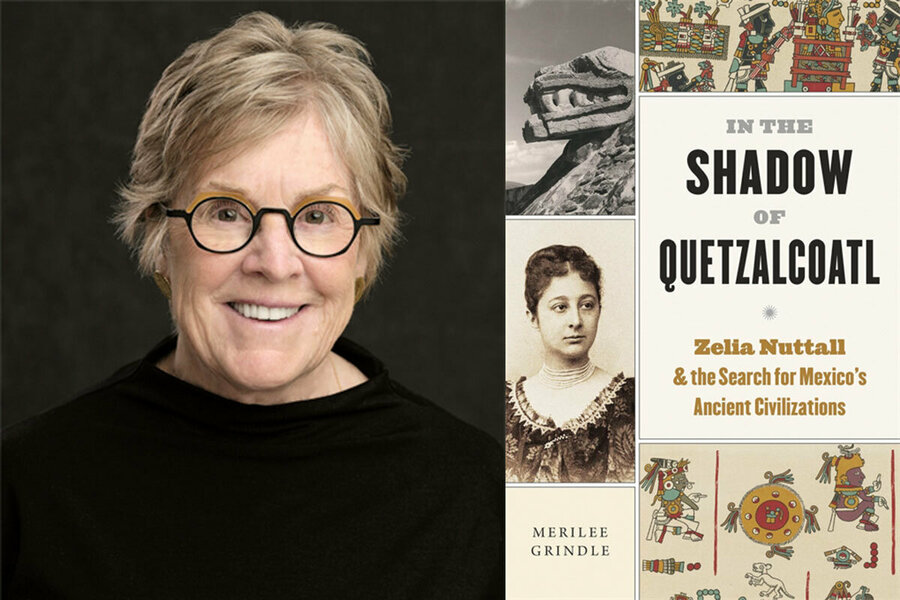Her quest was to excavate not the soil, but the record
Loading...
With her book “In the Shadow of Quetzalcoatl: Zelia Nuttall and the Search for Mexico’s Ancient Civilizations,” Merilee Grindle acquaints readers with the first anthropologist to fully decipher the Aztec calendar stone. The stone, which was uncovered in 1790 in Mexico City, was a gateway to understanding Aztec rituals. The dogged research into the calendar and other artifacts by Zelia Nuttall (1857-1933) was critical to the understanding of early Mesoamerican history and culture. Nuttall was self-taught in what was then a new field of study that employed few women, and her contributions have been largely forgotten. Until now. Dr. Grindle spoke recently with the Monitor.
What attracted you to this story?
I was working on another project when I stumbled onto information about Zelia and started looking into her life. My initial take was, here’s an interesting woman who had done some rather remarkable things, but who has been completely forgotten. I was struck by the way in which the arc of her life intersected with some very important things happening in the United States and in Mexico: A fascination with science. An accumulation of wealth after the Civil War that sparked private philanthropy to fund libraries, museums, universities, botanical gardens, and other urban attractions. It was very much the Gilded Age. In Mexico, the era encouraged new interest in a national origin story. Where did we come from? Who were the great people of the past and the gods they worshipped? Her work was really driven by those kinds of interests.
What were Nuttall’s outstanding qualities as an anthropologist?
It was her ability to look and to categorize and to delve deeply into whatever written record there was to understand what ancient things were and what they meant. Anthropology and archaeology at the time were largely concerned with describing. Finding and describing and interpreting were the things that she did over and over and over again. It was a combination of looking carefully, usually at fairly small artifacts, and then drawing on other sources to define clearly what those things were. And she looked closely at artifacts and then compared them with what she knew about the earlier written or pictographic record.
How did Nuttall, born at a time when opportunities for women were so limited, come to have such a long and distinguished career?
Through her teenage years she was quite conventional. She slowly came to understand that she perhaps had something more to offer than a typical young woman of the time. She married a linguist who introduced her to various aspects of anthropology and gave her access to his incredible library of documents and books about ancient Mesoamerica. She became fascinated by the topic and couldn’t get enough of it. Most anthropologists at the time were independent scholars. There were no universities that had departments of anthropology. Basically you had to make your own way. I think because of her elite upbringing, she knew how to network. How to get in touch with people who were leaders in the field. How to get in touch with people who had money who could support her work. Zelia was really, really good at that.
Did she contribute to the field of anthropology itself or influence its development?
She was there at the founding [of the discipline] and was an important actor in helping form some of the initial associations. She was very influential in building museum collections at Harvard and the University of Pennsylvania and the University of California.
Despite her fame, by the end of her life, she was largely forgotten. Why?
By the 1920s, more and more anthropologists were going to university and getting degrees, where Zelia’s generation has been mostly self-taught. There was a kind of professionalization of the discipline, which left her behind. Then, too, by the 1920s she confronted a new world in post-revolutionary Mexico, one that was interested in a different origin story, that was interested in telling the story of ordinary people, not just the kings and gods of the past.
Did you have any surprises or unexpected discoveries about Nuttall in your research?
It was surprising that she sued for divorce. She was [a member of the elite], part of San Francisco society in the late 1800s, raised in the Roman Catholic faith, and here she was, two years after getting married, suing for separation and eventually divorce. She worked through the courts to ensure that she got custody of her daughter and that she could reclaim her maiden name. That’s really quite remarkable for a person of her time.
What does the title of the book mean?
Quetzalcoatl, the feathered serpent god, was recognized by ancient civilizations throughout Mesoamerica. To the Aztecs, Quetzalcoatl was associated with creation, learning, art, wind, and wisdom. To me, Quetzalcoatl represents so much about ancient Mexico. And the title just seemed like this was her quest – to excavate, not necessarily in the soil, but to excavate in the record, to light up shadow.







